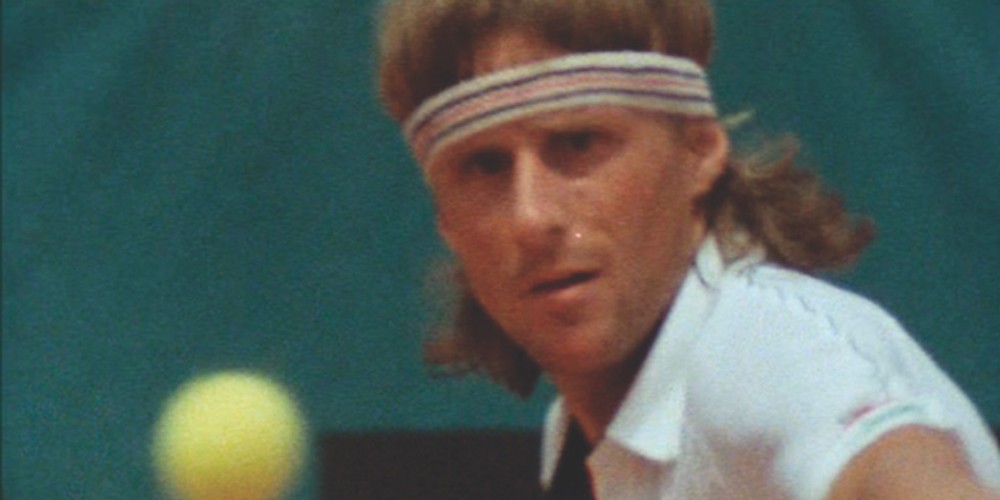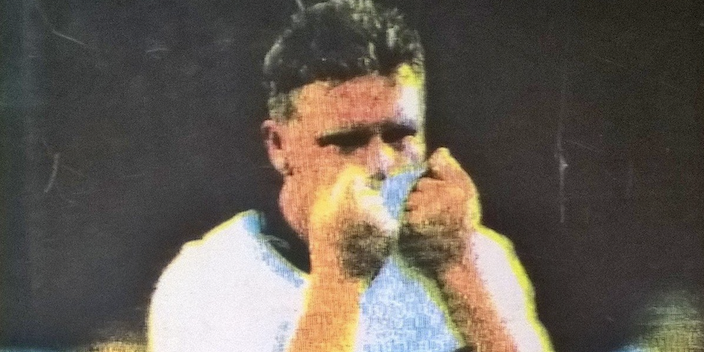THERE’S ONE GOOD FOLDER on my computer desktop. “Images,” its title reads, opaquely, enticingly. Inside, one can find a curated compendium of visual curios, pop-culture bric-a-brac, and internet detritus: a mud-speckled Sidney Poitier adjusting his amber motocross goggles in a still from 1973’s A Warm December; an uncanny stock image of a smiling, multiracial group of men and women standing in V-formation against an antiseptic white backdrop. A recent favorite is a Walter Iooss Jr. photograph of former Pittsburgh Pirates All-Star outfielder Dave Parker smoking a cigarette in the dugout during a 1980 spring-training game. For the sports-loving aesthete, it’s
- print • June/July/Aug 2022
- print • June/July/Aug 2022
AS THE NEW YORK YANKEES remain baseball’s Unavoidable Fact, even when mediocre, so have the Los Angeles Lakers been nearly impossible for basketball fans to escape, despite having just completed one of their most maladroit seasons in recent memory. (For the benefit of those who neither know nor care, this year’s edition finished 33–49, even with reigning-if-aging superstar-in-chief LeBron James on the roster.) The reasons for the Lakers’ omnipresence are not obscure: even casual sports fans know how dominant the Lakers franchise has been in the global pop-cultural psyche since the 1980s, when a team once acknowledged by fans as
- print • June/July/Aug 2022
MIDWAY THROUGH GRADUATE SCHOOL, I started to dislike reading. I spent my days skimming academic articles and my evenings skimming novels in search of quotes for my dissertation. I turned to television: sitcoms and basketball. When I developed insomnia, I returned to books—books about basketball.
- print • June/July/Aug 2022
“THE MINDSET WAS PREDISPOSED TO BE NEGATIVE,” the writer Pete Davies said not long ago. We were discussing English attitudes in the run-up to the 1990 World Cup—Italia ’90—the subject of his elating travelogue, All Played Out, often described as the greatest book about soccer. The national game had been in a bad way—the playing style primitive, the supporters feral. An article by Brian Glanville, a prominent reporter, carried the headline “England Abroad: Shame and Mediocrity.” The general prognosis was that the team would be, in Davies’s word, “shit,” that “we’d be an embarrassment” both on and off the pitch.
- print • June/July/Aug 2022
LAST FEBRUARY, with the NHL’s 2020–21 pandemic-shortened season just a month old, The Atlantic published an impertinent provocation: “Hockey Has a Gigantic-Goalie Problem.” The title was literal. Ken Dryden’s piece traced the sport’s arms race, as the refinement of the slap shot and the switch from wooden sticks to lighter composites turned pucks into lethal missiles. This required additional padding for the netkeeper, while the dimensions of his domain remained the same. Amid a worldwide health crisis, Dryden’s jeremiad made it sound like oversize equipment jeopardized the spirit of the game, if not civilization itself.
- print • June/July/Aug 2022
OTHER THAN BEING among the moneyed elite, what do Gwyneth Paltrow, Joe Rogan, and Laird Hamilton have in common? To various degrees, they all espouse the teachings of Wim Hof, a jolly Dutchman better known as “The Iceman” for feats like climbing Mount Kilimanjaro shirtless, running a half marathon barefoot across ice and snow, running a full marathon across the Namibian desert without breaking for water, and generally exhorting the public to understand that wearing a T-shirt out in winter while saying you just don’t get cold is more than manboy behavior. For Hof, it’s the secret to the good
- print • June/July/Aug 2022
I WAS EIGHT THAT YEAR. The Indian cricket team won an unlikely victory against the West Indies during their Caribbean tour in 1971. I discovered this from the color photographs in the Illustrated Weekly of India—a young Sunil Gavaskar, his sleeves rolled up, holding his bat aloft after stylishly driving through the covers. The red cricket ball shone like a cherry on the lush green outfield. The whites worn by the cricketers, the wooden bats with their straight lines and subtle curves, the dark borders on Gavaskar’s sweater. I cut out those pictures and made my first scrapbook. Which is
- print • June/July/Aug 2022
RENÉE RICHARDS, eighty-seven, has admitted she has some regrets. Among them is that she never pitched for the New York Yankees, a job MLB scouts once seemed to think she had a real shot at.
- print • June/July/Aug 2022
THE BALL SLINGS INTO THE NET, and by the time the camera pans back to Brandi Chastain, she has whipped off her shirt and is twirling it in the air above her head. Then she drops to her knees. For about six seconds, she is alone with her accomplishment. That’s the time it takes for her teammates to run to her from the center line, engulfing her in a raucous, cheering group hug. Chastain had won the 1999 Women’s World Cup—only the third ever such tournament—for the United States, on a penalty kick.
- print • June/July/Aug 2022
RUSSIA’S INVASION OF UKRAINE has been a boon for American oil and gas companies, Russian bond traders at Goldman Sachs, and chess grandmaster Garry Kasparov. The former world champion and staunch critic of Putin has become a regular guest on prime-time cable news slots. He’s penned op-eds in the Wall Street Journal and the Chicago Tribune. His 2015 book, Winter Is Coming, which predicted that Putin would invade Ukraine beyond its eastern regions, has rocketed to the top of Amazon’s charts and journalists’ recommended-reading lists. Kasparov is quoted by the press as though he were an oracle. Grandmasters, the saying
- print • June/July/Aug 2022
RICHARD WILLIAMS DEMANDS GLORY. The pursuit of glory is revised madness, the ambition of addicts, to get so high they collapse, and are forced to repeat the ascent as if for the first time. It’s preemptive repentance disguised as innocent yearning to win. You have to need vindication to need victory so desperately. Richard Williams is looking for redemption. In a scene from a 1990s video of Richard, father of tennis champions Venus and Serena Williams, we see him genuflecting on a tennis court in Compton, California, in front of a shopping cart full of tennis balls—the ground swells with
- print • June/July/Aug 2022
A TENNIS MATCH HAS AT LEAST FORTY-EIGHT BEGINNINGS and endings; you need to win a minimum of forty-eight points to win a match. An orchestra traditionally receives a single round of applause at the conclusion of a performance. A professional tennis player at a large tournament is applauded after every point.
- review • May 31, 2022
At the height of the pandemic, sports stadiums took on an eerie quality: they became so quiet. It was a stark reminder of the symbiotic relationship between star athletes and fans. If a great goal is scored and no one cheers, does it even exist? It must, because we still watched from afar, and were moved by those roarless games. And as stadiums reopened, the hunger for sports—and the connections and rivalries among fans—proved to be as strong as ever. Following our favorite teams, we obsess, we admire, and we are disappointed, because even the best players can’t win them
- print • June/July/Aug 2022
LET ME TELL YOU about the left hand of Marcus Smart, how it rose above the heads of three defenders to bank in a basket with 1:10 to play in the fourth quarter of the second game of the first round of the playoffs. We are in Boston, Massachusetts, and it is Wednesday, April 20; we are in the Eastern Conference of the National Basketball Association. Marcus Smart, recently named Defensive Player of the Year, the first time he’s won this award, the first time a guard—a little guy—has won this award since Gary Payton (aka “the Glove”) won it
- print • June/July/Aug 2022
SEVERAL YEARS AGO, while visiting my parents’ house, I found an artifact of my tortured early years of baseball fandom. It was a journal I was assigned to keep at the beginning of first grade, a stretch of time in the autumn of 1993 that coincided with a thrillingly unexpected Philadelphia Phillies postseason run. “I like the Phillies,” I wrote on October 8—a rather bold statement, given that the Greg Maddux–led Atlanta Braves had clobbered them 14–3 in Game 2 of the National League Championship Series the night before. I added several small crayon illustrations, as if placing my modest
- excerpt • May 10, 2022
Sickness narratives do not always start with symptoms and end in recovery. Treatment does not always follow test. A new diagnosis might arrive at any time, or never. Sick time is not linear time. It is circular. It lapses and relapses, it drags, loops and buffers.
- review • April 26, 2022
In 1994, poet Fanny Howe was travelling in the UK and working intermittently. She spun this experience into London-rose, a poetic and philosophic meditation on alienation, labor, and everyday life. The book is being published for the first time this month by Semiotext(e). Below is a brief dispatch from her journey. —The Editors
- review • April 21, 2022
The first four nodes of ARPANET—the Department of Defense’s primeval internet—were connected in 1969, the very year that Theodor W. Adorno died. In retrospect, it seems a cruel coincidence; it is difficult to imagine a cultural technology more deserving of Adorno’s truculent analysis than the internet, or to locate a comparable living thinker able to explain why a worldwide network that was supposed to unite everyone and improve everything tremors with feelings of disconnection and debasement.
- excerpt • March 8, 2022
There is a conventional wisdom about memoir that claims a writer must have sufficient hindsight in order to write meaningfully about her past. This has not been my experience. All that has been required of me to write about something is this change of heart. A shift toward, or away, or perhaps a desire to return to some truer version of myself. I don’t even have to know that I’ve made it, but when I look back at the beginnings of everything I’ve ever written, there it is.
- print • Mar/Apr/May 2022
WHEN SUN RA BEAMS into an Oakland, California, community center as an intergalactic ambassador from the council of outer space in the 1974 science-fiction movie Space Is the Place, one of the young men in the crowd asks, “Why are your shoes so big?” Ra, the experimental poet, composer, and jazz musician, is wearing platform shoes gussied up with intergalactic flair, which warrant the flippant and incredulous response. But after Ra is asked if he is real, the mocking wonder of the group of Black earthlings gradually dissipates as he answers, “How do you know I’m real? I’m not real.



















